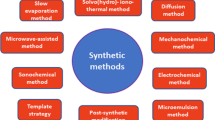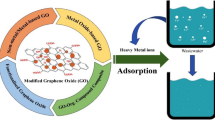Abstract
Discharge of oil water from industrial activities can have significant effects on environment with potentially considerable economic consequences. Some current approaches to oil and polycyclic aromatic hydrocarbon (PAH) remediation do not lead to any desired effect and may have detrimental environmental results. However, oil pollution remediation was developed through nanotechnology via oil-absorbing method. In this work, a simple hydrothermal approach for preparing poly(lauryl acrylate)-grafted magnetite Fe3O4 nanoparticles (GMNPs) to separate PAH, i.e., naphthalene from water is presented with a high removal efficiency under relevant conditions. At first, the Fe3O4 NPs were synthesized and then chemical modification was performed through the reaction with (3-aminopropyl) triethoxysilane (APTES) and acryloyl chloride (AC) as sequentially polymerizable groups. Finally, poly(lauryl acrylate) was grafted to the modified Fe3O4 via free radical polymerization technique to form hydrophobic surfaces for absorbing naphthalene selectively. The results disclosed that as-prepared adsorbent exhibited high specific surface area (105.36 m2/g). The removal efficiency was optimized for the most important variables, e.g., pH and contact time and the highest removal efficiency (%) was obtained 97.4%. Furthermore, kinetic and equilibrium function of the absorbent in the absorption process was investigated in detail and correlated with pseudo-second-order and Freundlich model, respectively, and maximum adsorption capacity was about 32.87 mg/g. Moreover, this adsorbent can be eliminated from solution through applying an external magnet and then recycled and re-used in five consecutive cycles, successfully.
Graphical abstract














Similar content being viewed by others
References
Torabian A, Panahi HA, Nabi Bid Hendi GR, Mehrdadi N (2014) Synthesis, modification and graft polymerization of magnetic nano particles for PAH removal in contaminated water. J Environ Health Sci Eng 12:105. https://doi.org/10.1186/2052-336X-12-105
Torabian A, Kazemian H, Seifi L, Nabi Bidhendi G, Azimi AA, Ghadiri SK (2010) Removal of petroleum aromatic hydrocarbons by surfactant-modified natural zeolite: the effect of surfactant. Clean: Soil, Air, Water 38:77–83. https://doi.org/10.1002/clen.200900157
Bayat A, Aghamiri SF, Moheb A, Vakili-Nezhaad GR (2005) Oil spill cleanup from sea water by sorbent materials. Chem Eng Technol 28:1525–1528. https://doi.org/10.1002/ceat.200407083
Ivshina IB, Kuyukina MS, Krivoruchko AV, Elkin AA, Makarov SO, Cunningham CJ, Peshkur TA, Atlas RM, Philp JC (2015) Oil spill problems and sustainable response strategies through new technologies. Environ Sci: Processes Impacts 17:1201–1219. https://doi.org/10.1039/C5EM00070J
Mapelli F, Scoma A, Michoud G, Aulenta F, Boon N, Borin S, Kalogerakis N, Daffonchio D (2017) Biotechnologies for marine oil spill cleanup: in dissoluble ties with microorganisms. Trends Biotechnol 35:860–870. https://doi.org/10.1016/j.tibtech.2017.04.003
Zhou Y, Lu J, Zhou Y, Liu Y (2019) Recent advances for dyes removal using novel adsorbents: a review. Environ Pollut 252:352–365. https://doi.org/10.1016/j.envpol.2019.05.072
Song Y, Fang G, Zhu C, Zhu F, Wu S, Chen N, Wu T, Wang Y, Gao J, Zhou D (2019) Zero-valent iron activated persulfate remediation of polycyclic aromatic hydrocarbon-contaminated soils: an in situ pilot-scale study. Chem Eng J 355:65–75. https://doi.org/10.1016/j.cej.2018.08.126
Duan L, Naidu R, Thavamani P, Meaklim J, Megharaj M (2015) Managing long-term polycyclic aromatic hydrocarbon contaminated soils: a risk-based approach. Environ Sci Pollut Res 22:8927–8941. https://doi.org/10.1007/s11356-013-2270-0
Li Y, Liao X, Huling SG, Xue T, Liu Q, Cao H, Lin Q (2019) The combined effects of surfactant solubilization and chemical oxidation on the removal of polycyclic aromatic hydrocarbon from soil. Sci Total Environ 647:1106–1112. https://doi.org/10.1016/j.scitotenv.2018.07.420
Mao J, Luo Y, Teng Y, Li Z (2012) Bioremediation of polycyclic aromatic hydrocarbon-contaminated soil by a bacterial consortium and associated microbial community changes. Int Biodeterior Biodegrad 70:141–147. https://doi.org/10.1016/j.ibiod.2012.03.002
Kuppusamy S, Thavamani P, Venkateswarlu K, Lee YB, Naidu R, Megharaj M (2017) Remediation approaches for polycyclic aromatic hydrocarbons (PAHs) contaminated soils: technological constraints, emerging trends and future directions. Chemosphere 168:944–968. https://doi.org/10.1016/j.chemosphere.2016.10.115
Cho E, Tahir MN, Choi JM, Kim H, Yu J-H, Jung S (2015) Novel magnetic nanoparticles coated by benzene-and β-cyclodextrin-bearing dextran, and the sorption of polycyclic aromatic hydrocarbon. Carbohydr Polym 133:221–228. https://doi.org/10.1016/j.carbpol.2015.06.089
Boon YH, Zain NNM, Mohamad S, Osman H, Raoov M (2019) Magnetic poly (β-cyclodextrin-ionic liquid) nanocomposites for micro-solid phase extraction of selected polycyclic aromatic hydrocarbons in rice samples prior to GC-FID analysis. Food Chem 278:322–332. https://doi.org/10.1016/j.foodchem.2018.10.145
Demortiere A, Panissod P, Pichon BP, Pourroy G, Guillon D, Donnio B, Begin-Colin S (2011) Size-dependent properties of magnetic iron oxide nanocrystals. Nanoscale 3:225–232. https://doi.org/10.1039/C0NR00521E
Chi Z, Zhu Y, Liu W, Huang H, Li H (2021) Selective removal of As(III) using magnetic graphene oxide ion-imprinted polymer in porous media: potential effect of external magnetic field. J Environ Chem Eng 9:105671. https://doi.org/10.1016/j.jece.2021.105671
Huang C, Hu B (2008) Silica-coated magnetic nanoparticles modified with γ-mercaptopropyltrimethoxysilane for fast and selective solid phase extraction of trace amounts of Cd, Cu, Hg, and Pb in environmental and biological samples prior to their determination by inductively coupled plasma mass spectrometry. Spectrochim Acta Part B At Spectrosc 63:437–444. https://doi.org/10.1016/j.sab.2007.12.010
Yan J, Li K (2021) A magnetically recyclable polyampholyte hydrogel adsorbent functionalized with β-cyclodextrin and graphene oxide for cationic/anionic dyes and heavy metal ion wastewater remediation. Sep Purif Technol 277:119469. https://doi.org/10.1016/j.seppur.2021.119469
Yang N, Zhu S, Zhang D, Xu S (2008) Synthesis and properties of magnetic Fe3O4-activated carbon nanocomposite particles for dye removal. Mater Lett 62:645–647. https://doi.org/10.1016/j.matlet.2007.06.049
Kumari M, Gupta SK (2020) A novel process of adsorption cum enhanced coagulation flocculation spiked with magnetic nanoadsorbents for the removal of aromatic and hydrophobic fraction of NOM along with turbidity from drinking water. J Clean Prod 244:118899. https://doi.org/10.1016/j.jclepro.2019.118899
Kumari M, Gupta SK (2018) Removal of aromatic and hydrophobic fractions of natural organic matter (NOM) by surfactant modified magnetic nanoadsorbents (MNPs). Environ Sci Pollut Res 25:25565–25579. https://doi.org/10.1007/s11356-018-2611-0
Daifullah AAM, Girgis BS (2003) Impact of surface characteristics of activated carbon on adsorption of BTEX. Colloids Surf A Physicochem Eng Asp 214:181–193. https://doi.org/10.1016/S0927-7757(02)00392-8
Goswami R, Deb P, Thakur R, Sarma KP, Basumallick A (2011) Removal of As (III) from aqueous solution using functionalized ultrafine iron oxide nanoparticles. Sep Sci Technol 46:1017–1022. https://doi.org/10.1080/01496395.2010.537728
Lu A-H, Salabas EL, Schüth F (2007) Magnetic nanoparticles: synthesis, protection, functionalization, and application. Angew Chem Int Ed 46:1222–1244. https://doi.org/10.1002/anie.200602866
Shariati S, Faraji M, Yamini Y, Rajabi AA (2011) Fe3O4 magnetic nanoparticles modified with sodium dodecyl sulfate for removal of safranin O dye from aqueous solutions. Desalination 270:160–165. https://doi.org/10.1016/j.desal.2010.11.040
Wei Z, Ma X, Zhang Y, Guo Y, Wang W, Jiang Z-Y (2022) High-efficiency adsorption of phenanthrene by Fe3O4-SiO2-dimethoxydiphenylsilane nanocomposite: experimental and theoretical study. J Hazard Mater 422:126948. https://doi.org/10.1016/j.jhazmat.2021.126948
Khodakarami M, Bagheri M (2021) Recent advances in synthesis and application of polymer nanocomposites for water and wastewater treatment. J Clean Prod 296:126404. https://doi.org/10.1016/j.jclepro.2021.126404
Chu Y, Pan Q (2012) Three-dimensionally macroporous Fe/C nanocomposites as highly selective oil-absorption materials. ACS Appl Mater Interfaces 4:2420–2425. https://doi.org/10.1021/am3000825
Damavandi F, Soares JBP (2022) Polystyrene magnetic nanocomposite blend: an effective, facile, and economical alternative in oil spill removal applications. Chemosphere 286:131611. https://doi.org/10.1016/j.chemosphere.2021.131611
Ma J, Fu X, Xia W, Zhang R, Fu K, Wu G, Jia B, Li S, Li J (2021) Removal of emulsified oil from water by using recyclable chitosan based covalently bonded composite magnetic flocculant: performance and mechanism. J Hazard Mater 419:126529. https://doi.org/10.1016/j.jhazmat.2021.126529
Thanikaivelan P, Narayanan NT, Pradhan BK, Ajayan PM (2012) Collagen based magnetic nanocomposites for oil removal applications. Sci Rep 2:230. https://doi.org/10.1038/srep00230
Calcagnile P, Fragouli D, Bayer IS, Anyfantis GC, Martiradonna L, Cozzoli PD, Cingolani R, Athanassiou A (2012) Magnetically driven floating foams for the removal of oil contaminants from water. ACS Nano 6:5413–5419. https://doi.org/10.1021/nn3012948
Silva VAJ, Andrade PL, Silva MPC, Bustamante DA, Valladares LDLS, Aguiar JA (2013) Synthesis and characterization of Fe3O4 nanoparticles coated with fucan polysaccharides. J Magn Magn Mater 343:138–143. https://doi.org/10.1016/j.jmmm.2013.04.062
Yu BY, Kwak SY (2010) Assembly of magnetite nanocrystals into spherical mesoporous aggregates with a 3-D wormhole-like pore structure. J Mater Chem 20:8320–8328. https://doi.org/10.1039/C0JM01274B
Valderrama C, Gamisans X, Cortina JL, Farran A, de las Heras FX (2009) Evaluation of polyaromatic hydrocarbon removal from aqueous solutions using activated carbon and hyper-crosslinked polymer (Macronet MN200). J Chem Technol Biotechnol 84:236–245. https://doi.org/10.1002/jctb.2030
Rinawati HD, Supriyanto R, Permana DF, Yunita, (2019) Adsorption of polycyclic aromatic hydrocarbons using low-cost activated carbon derived from rice husk. J Phys Conf Ser 1338:012005. https://doi.org/10.1088/1742-6596/1338/1/012005
Celebioglu A, Topuz F, Yildiz ZI, Uyar T (2019) Efficient removal of polycyclic aromatic hydrocarbons and heavy metals from water by electrospun nanofibrous polycyclodextrin membranes. ACS Omega 4:7850–7860. https://doi.org/10.1021/acsomega.9b00279
Wan D, Chen F, Geng Q, Lu H, Willcock H, Liu Q, Wang F, Zou K, Jin M, Pu H, Du J (2014) A multifunctional azobenzene-based polymeric adsorbent for effective water remediation. Sci Rep 4:7296. https://doi.org/10.1038/srep07296
Kim D-Y, Han G-T, Shin H-S (2021) Adsorption of polycyclic aromatic hydrocarbons (PAHs) by cellulosic aerogels during smoked pork sausage manufacture. Food Control 124:107878. https://doi.org/10.1016/j.foodcont.2021.107878
Hall S, Tang R, Baeyens J, Raf D (2009) Removing polycyclic aromatic hydrocarbons from water by adsorption on silicagel. Polycycl Aromat Comp 29:160–183. https://doi.org/10.1080/10406630903017534
Crisafully R, Milhome MAL, Cavalcante RM, Silveira ER, Keukeleire DD, Nascimento RF (2008) Removal of some polycyclic aromatic hydrocarbons from petrochemical wastewater using low-cost adsorbents of natural origin. Bioresource Technol 99:4515–4519. https://doi.org/10.1016/j.biortech.2007.08.041
Author information
Authors and Affiliations
Corresponding author
Ethics declarations
Conflict of interest
There are no conflicts to declare.
Rights and permissions
About this article
Cite this article
Ghasemi, S., Abareshi, H. Nanocomposite based on poly(lauryl acrylate)-grafted Fe3O4 for polycyclic aromatic hydrocarbon removal from water. Iran Polym J 31, 1003–1019 (2022). https://doi.org/10.1007/s13726-022-01056-6
Received:
Accepted:
Published:
Issue Date:
DOI: https://doi.org/10.1007/s13726-022-01056-6




